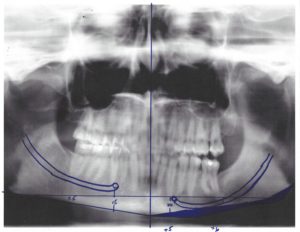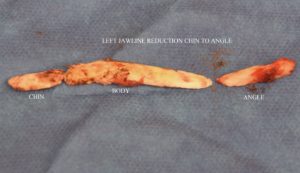Facial asymmetry is not all that uncommon and can occur for a variety of reasons and in different degrees of expression. But the most common reason for facial asymmetry is developmental that becomes apparent as facial growth completes by late teenage years. In the majority of developmental facial asymmetry cases, the abnormal side is positioned lower. It is very rare to have the normal side be the ‘low’ side and the abnormal side be the ‘high’ side.
One of the most conspicuous features of many facial asymmetry cases is the lower jawline. The affected jawline hangs lower and is obviously different than the other side since it is an edge or profile facial feature. X-rays will show that the jawline is usually vertically longer and even the intraosseous inferior alveolar nerve canal and tooth root positions are lower than the other side. This may be associated with a cant to the occlusal plane.

The best and most accurate method to perform an inferior border reduction of the lower jaw (inferior jawline shave) is from a submental approach. While many patients would prefer an intraoral approach, this makes it very difficult (if not impossible) to make an accurate line of reduction and also places the mental nerve at risk of injury. While the submental incision creates a small fine line scar, it offers a bone cut that can be made with a direct line of sight back to the jaw angle.

Dr. Barry Eppley
Indianapolis, Indiana


